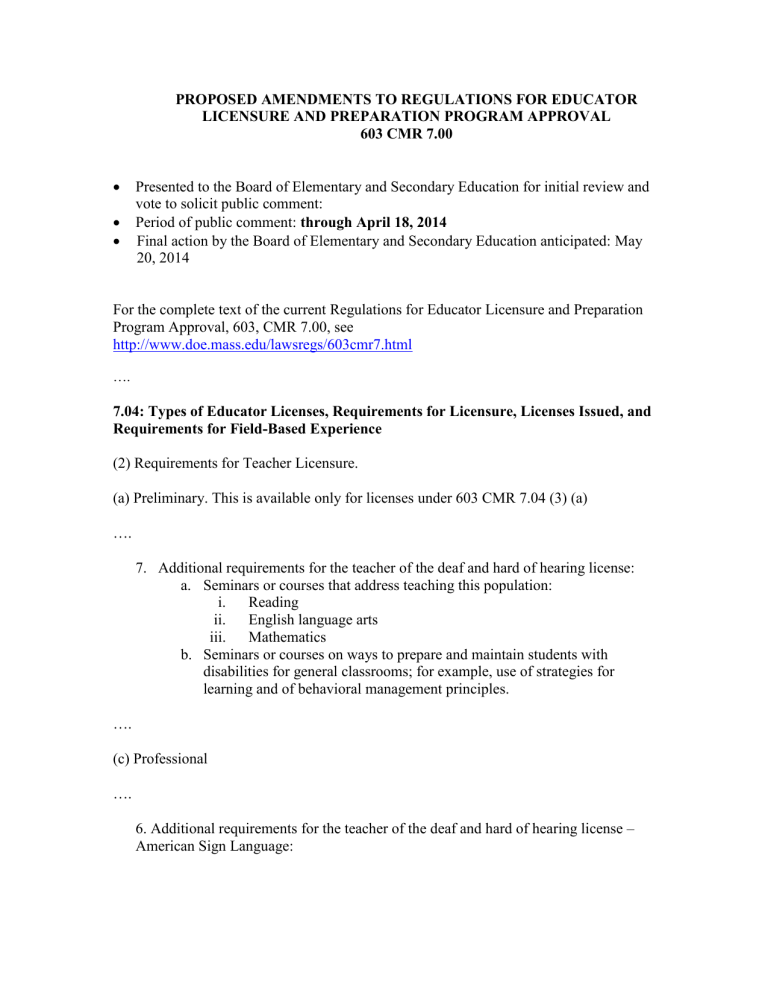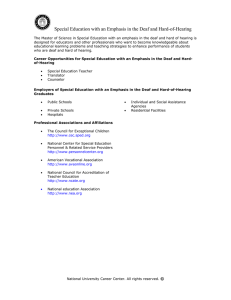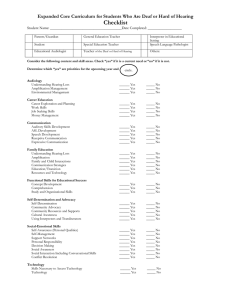item1 p603cmr7 Clean

PROPOSED AMENDMENTS TO REGULATIONS FOR EDUCATOR
LICENSURE AND PREPARATION PROGRAM APPROVAL
603 CMR 7.00
Presented to the Board of Elementary and Secondary Education for initial review and vote to solicit public comment:
Period of public comment: through April 18, 2014
Final action by the Board of Elementary and Secondary Education anticipated: May
20, 2014
For the complete text of the current Regulations for Educator Licensure and Preparation
Program Approval, 603, CMR 7.00, see http://www.doe.mass.edu/lawsregs/603cmr7.html
….
7.04: Types of Educator Licenses, Requirements for Licensure, Licenses Issued, and
Requirements for Field-Based Experience
(2) Requirements for Teacher Licensure.
(a) Preliminary. This is available only for licenses under 603 CMR 7.04 (3) (a)
….
….
7.
Additional requirements for the teacher of the deaf and hard of hearing license: a.
Seminars or courses that address teaching this population: i.
Reading ii.
English language arts iii.
Mathematics b.
Seminars or courses on ways to prepare and maintain students with disabilities for general classrooms; for example, use of strategies for learning and of behavioral management principles.
(c) Professional
….
6. Additional requirements for the teacher of the deaf and hard of hearing license –
American Sign Language:
a.
Passing score on a test of American Sign Language approved by the
Department.
….
7.06: Subject Matter Knowledge Requirements for Teachers
….
(27) Teacher of the Deaf and Hard-of-Hearing: American Sign Language/Total
Communication or Oral/Aural (Levels: All)
….
(b) The following topics shall be included in an approved program but will not be addressed on a written test of subject matter knowledge:
1.
Theories of language acquisition for American Sign Language (ASL) and English in hearing and deaf and hard-of-hearing children.
2.
Theories on the relationship between ASL and the English language.
3.
Similarities and differences in the linguistic structure of ASL and English.
4.
Benefits and limitations of ASL, spoken English, and printed English for learning, and the instructional strategies for using them.
5.
Knowledge of how deaf people live their daily lives.
6.
Historical and current developments in deaf education in the United States and other countries.
7.
Features of family support and services.
8.
Similarities and differences between hearing and deaf and hard-of-hearing students in emotional, social, and intellectual development.
9.
Ways to prepare deaf and hard-of-hearing students for classrooms ranging from general education classrooms to schools for the deaf and hard of hearing.
10.
Design or modification of the curriculum and instructional materials for the deaf and hard-of-hearing.
11.
Modifications of theories of reading for hearing children necessary for the learning of reading by deaf and hard-of-hearing children.
12.
General and specific effects of hearing loss upon the production of speech and the reception of speech and other sounds.
13.
General and specific effects of visual processing and reception of a visual language and its acquisition.
14.
Anatomy and physiology of human speech, hearing, and language mechanisms.
15.
Knowledge of state-of-the-art diagnostic instruments; procedures for testing and interpreting results.
16.
Characteristics of types of amplification equipment and their uses by teachers and students.
17.
Medical, social, ethical, and educational research relating to the deaf and hard-ofhearing, including the effects of cochlear implants on language learning.
18.
Preparation, implementation, and evaluation of Individualized Education
Programs (IEPs).
19.
Federal and state laws pertaining to special education.
20.
Science laboratory work.
21.
Child development.
1.
Basic theories of cognitive, social, emotional, language, and physical development from childhood through adolescence.
2.
Characteristics and instructional implications of moderately and severely disabling conditions.
22.
Reading theory, research, and practice.
1.
Knowledge of the significant theories, approaches, practices, and programs for developing reading skills and reading comprehension, particularly for students who are Deaf or hard of hearing and use
American Sign Language.
2.
Phonemic awareness and phonics or alternative methods and strategies for teaching comparable concepts not dependent on sound and based on the components of ASL: principles, knowledge, and instructional practices related to these methods.
3.
Diagnosis and assessment of reading skills using standardized, criterionreferenced, and informal assessment instruments.
23.
Development of an expressive and receptive vocabulary, both for expressive communication, including writing, and receptive comprehension, including reading.
24.
Theories on the relationships between beginning writing and reading for both hearing and Deaf students.
25.
Theories of first and second language acquisition and development and their impact on learning to read for students who are Deaf or hard of hearing.
(c) For the Teacher of the Deaf and Hard-of-Hearing: American Sign Language/Total
Communication:
….
1. Passing score on a test of American Sign Language approved by the Department.
7.15: General Provisions
….
(5) Renewal of an Initial License.
(a) An educator may renew an Initial license one time for an additional five years of employment. The decision of the Commissioner shall be final.
(b) In order to be eligible for such renewal a candidate shall:
1.
Have been employed for five years under a valid Initial license.
2.
Present evidence of sound moral character.
3.
Submit a plan outlining how the candidate will fulfill the requirements for a
Professional license.
4.
Additional requirements for the teacher of the deaf and hard of hearing license –
American Sign Language: a.
Passing score on a test of American Sign Language approved by the
Department.


